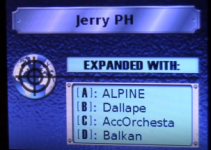Some of you 8X owners may know about the Equalizer, but maybe not all of you. Before I begin, I want to say that I never would have found the Equalizer, if I did not have “Conversations” on this forum with Ventura. He doesn’t have an 8X, but has a large amount of knowledge on the development of the Roland Virtual accordion. With his background/knowledge, and my “poking around”, I found where to access the Equalizer.
I could not find any information in the 8X manual on the EQ, except on page 72 menu item 2.3. The Equalizer is MFX Type No. 2 (Stereo EQ). I describe the features below:
● The 8X has a 4 band Equalizer (Low, Mid 1, Mid 2, and High)
● Each band has:
∆ Adjustable Center Frequency
∆ Gain (+/- 15db) Adjust
∆ Q (0.5-8.0) Adjust on Mid 1 and Mid 2
∆ Level Adjust across all bands
● In the “Accordion” section, the EQ can be set to modify any of the 33 Reed types along with all of their different footages
● The Equalizer can also be used on any of the “Orchestra 1 and 2” sections
● The Equalizer can also be used on the Left Hand Orchestral Chord section
For me, learning about the Equalizer, has really opened up a new world of tones/sounds that can be created and the existing ones modified on the 8X.
I am going to have a lot of fun experimenting with the “tweaking” of different tones/sounds.
I could not find any information in the 8X manual on the EQ, except on page 72 menu item 2.3. The Equalizer is MFX Type No. 2 (Stereo EQ). I describe the features below:
● The 8X has a 4 band Equalizer (Low, Mid 1, Mid 2, and High)
● Each band has:
∆ Adjustable Center Frequency
∆ Gain (+/- 15db) Adjust
∆ Q (0.5-8.0) Adjust on Mid 1 and Mid 2
∆ Level Adjust across all bands
● In the “Accordion” section, the EQ can be set to modify any of the 33 Reed types along with all of their different footages
● The Equalizer can also be used on any of the “Orchestra 1 and 2” sections
● The Equalizer can also be used on the Left Hand Orchestral Chord section
For me, learning about the Equalizer, has really opened up a new world of tones/sounds that can be created and the existing ones modified on the 8X.
I am going to have a lot of fun experimenting with the “tweaking” of different tones/sounds.
Last edited:

